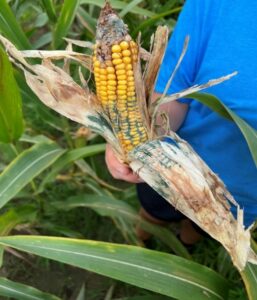Penicillium Ear Rot

Penicillium ear rot (PER) is a worldwide disease, caused by numerous species of Penicillium, some of which produces mycotoxins such as ochratoxins.
Symptoms: Penicillium spp. can cause damage in the field and in stored grain. Diseased kernels have a green, blue-green, or denim-blue, powdery mold. Infected kernels can appear bleached or streaked. If stored at high moisture, the pathogen may enter kernels and grow in the germ causing the symptom known as “blue-eye”.
Favorable conditions: Inoculum overwinter in the soil and other host plants. Spores can disperse by wind and rain and infect primarily damaged ears. This disease usually doesn’t require management.
Mycotoxins: Ochratoxins are toxic to swine and can cause porcine nephropathy. They are also toxic to chickens and ducks.